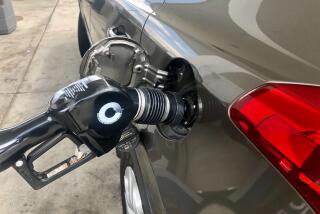Higher Gasoline Prices Seen on Horizon
- Share via
The cost of driving is poised to climb again after oil prices jumped back toward $40 a barrel Tuesday in response to concerns about disruptions of crude supplies at major exporting countries.
Another pipeline problem in Iraq and fears of oil-flow interruptions in Russia and Nigeria reignited the energy markets’ volatility, sending prices higher as U.S. traders returned from a three-day holiday weekend.
Crude oil for August delivery climbed $1.26, or 3.3%, to $39.65 a barrel on the New York Mercantile Exchange, its highest level in a month.
Oil prices had eased since hitting record highs in early June, and gasoline prices had followed suit. Indeed, the average pump price in California for the week ended Monday edged lower for the fifth week in a row, a government survey showed Tuesday.
The average cost of self-serve regular gas fell 3.3 cents in California to $2.204 a gallon, according to the Energy Department’s Energy Information Administration. That was down 5.3% from its record high of $2.327 a gallon for the week ended May 31 but still 41.9 cents higher than the average a year ago.
Nationwide, the average price in the latest week slipped 2.6 cents to $1.895 a gallon, the agency said.
But global petroleum supplies are tight and, with demand surging in the U.S., China and other nations, any potential for a disruption of oil exports prompts traders to bid prices higher, analysts said.
“The fact that the world is operating without this cushion keeps the markets very nervous,” said Seth Kleinman, an analyst at PFC Energy, a consulting firm in Washington. “It’s going to knock things back up to the $40 mark.”
That, in turn, promises to take a bigger bite out of motorists’ wallets. “The cost of crude just went up, and that’s the main cost in gasoline,” said Andrew Lebow, a broker with Man Financial Inc. in New York. “That’s going to lead to an increase in gasoline prices.”
Oil closed at a record $42.33 a barrel June 1 as a confluence of factors took hold: tight supplies, a “risk premium” built into prices that reflected terrorist fears, the unrelenting world demand for oil and efforts by the Organization of the Petroleum Exporting Countries to hold production at levels that would keep prices relatively high.
The risk premium had accounted for up to $10 of oil’s per-barrel record price, experts estimated. In the last few weeks, however, an absence of major disruptions to oil flows had reduced the premium, and traders turned their focus back to the oil markets’ supply and demand fundamentals.
But the risk factor resurfaced this weekend, when Iraqi exports were temporarily cut by nearly half after saboteurs attacked a pipeline in the southern part of the country. Officials said repairs on the pipeline neared completion Tuesday, and exports were expected to return to normal within a day. Still, that failed to arrest the jump in prices.
Other attacks in Iraq and in Saudi Arabia have caused oil prices to soar on three occasions since late April. Those two countries hold about one-third of the world’s proven oil reserves.
A work stoppage in Nigeria disrupted that country’s production this weekend. And the reliability of Russia’s exports came into question after one of its largest producers, Yukos, warned that its oil output might be pared within weeks because of a nasty tax dispute with the Russian government.
Another trigger could come Thursday, when the latest weekly figures on oil supplies and demand appear in separate reports from the Energy Information Administration and the American Petroleum Institute.
If the figures point to a further tightening of world oil supplies, “that could easily mean $40 oil,” Kleinman said.
OPEC, which pumps about one-third of the world’s oil, last month decided to raise its output quota by 2 million barrels a day, to 25.5 million barrels, as of Thursday. Its aim was to brake the surging price of oil. The cartel also had said it planned an additional boost of 500,000 barrels a day starting Aug. 1.
But Saudi Arabia and Nigeria added to the markets’ jitters last week when they signaled that the August increase might be unnecessary to keep prices stable. OPEC is scheduled to meet again July 21 in Vienna, and it probably will wait to see how high oil climbs before deciding whether to pump the additional oil as planned, analysts said.
*
Bloomberg News was used in compiling this report.
More to Read
Inside the business of entertainment
The Wide Shot brings you news, analysis and insights on everything from streaming wars to production — and what it all means for the future.
You may occasionally receive promotional content from the Los Angeles Times.











